It’s said that curiosity is the mother of invention – and it’s certainly the driver behind Angie Hughes’ richly layered textiles. This mixed media artist never knows how a piece is going to turn out. Her willingness to let go of outcomes, combined with a life-long curiosity to explore ‘what happens if…’ opens up a world of possibilities.
Angie’s emphasis on process takes time and she freely admits it can seem muddled, but it’s a fertile place from which inspiration and ideas emerge. Angie explores collage and components, working through ideas before moving onto fabric and stitch, as well as sampling to experiment with technique, materials and surface texture.
Her inspiration is as diverse as her techniques and might be sparked by a colour, words or an idea. It might reference the work of an anonymous medieval artist or poet, or be a response to life events and experiences. What she’s learnt is that the initial trigger is never the end point, and the journey is just as exciting as her final result.
Artist at play
Angie Hughes: I’m driven by a natural curiosity. What will happen if? That, mixed with an interest in the process. I like to explore how different materials and techniques work together. My influences can change from month to month. I’ll get excited by a shade of paint I’ve discovered or become obsessed by a new way to manipulate fabric. I’m currently interested in nature and how quickly it takes over when we leave the land alone. My direction changes again and again.
I’m not trying to express myself when making – I’m just trying to see if I can do it. With contemporary textiles, anything goes. You can’t really do it wrong.
I like using a collection of components when I’m making a piece. And I might use paper to play around with the composition and balance of the piece, before expanding with fabric and stitch. Recently I’ve been starting by painting papers in the approximate colours I think I’ll use. Then I’ll make a few collages while thinking about the theme or subject.
Having separate components means I can move everything around until it’s right – though it does mean I faff about a lot. I might tweak over 20 times before I’m content.
I don’t think I’ve ever made anything where I’ve known how it will look from day one.
Quite a lot of composition is spontaneous. I’ll remember a piece of textile or scrap of embroidery I did three years ago that I think would be ideal for what I’m working on and will then search all day to find it.
Since the pandemic, much of my work has been mainly stitched paper collage but I’m returning more to machine embroidery and fabric. So once I’ve played with the components in a collage, I’ll work out where and how to use my fabrics and stitch. I can draw but I prefer to explore textures and techniques first, then try to fit them together somehow. I jump around in many directions. It’s ‘muddly’ but something usually emerges when the dust settles.


Material mash-ups
I like to use velvet and linen mixed with paper and metallic surfaces – particularly black cotton velvet in combination with transfer foils and aluminium foil. I enjoy the contrast between the two surfaces as the black absorbs light and the foil reflects it. It’s very dynamic.
When I started working like this I was inspired by stained glass windows and hand painted icons – the gold against the dark really appealed to me and still does. When stitched, the velvet surface also has another effect, giving a lightly quilty surface, reflecting the light of the foils in different directions.
As a sample maker I’m always trying to mash up two or three materials to make an interesting new surface.
Using velvet can be difficult as it will creep against anything you lay on top of it. I attach organza with a little textile fabric adhesive, otherwise, it can ‘catch’ to the Bondaweb iron-on adhesive if I have transfer-foiled the velvet first. A line of stitch shows clearly against the layer of organza. I’ll do some stitched details then cut away the organza in areas where I’d like to see the velvet or foil clearly.


Follow the thread
I use machine embroidery for all the complex and decorative surfaces and lightly use hand stitch for small mark making, lines and spots. I use mostly Madeira Classic and Polyneon threads, which are quite shimmery and shiny. Wonderfil Spagetti is a top stitch thread that’s fabulous for outlining, making tendrils and generally raising the surface a little. Recently, I discovered Gütermann’s variegated cotton thread.
I prefer using variegated thread for everything as it softens and naturalises a surface. The cotton thread flattens reflections even more.
Variegated thread is particularly effective in my recent medieval-inspired works, which are influenced by nature reclaiming old buildings. I use the same threads for hand stitching to blend with the machine lines and fall back on DMC perlé for chunky knots and lines.
Top techniques
Because I’m a sample maker, I get going by starting with my favourite techniques, before perhaps trying something new that I’ve seen in a magazine.
I usually have several samples on the go at once. Quite often a really good sample evolves into a finished piece, or one piece can become three.
An early technique I used was making a flour and water paste for batik style effects – although I had a really old damp studio back then and slugs used to enjoy nibbling on my work overnight.
Transfer foiling is a favourite. It’s a foil carried on a cellophane film that will transfer onto a sticky surface like Bondaweb iron-on adhesive. It adds a very shiny and metallic layer, quite precious.
I like to use Vlieseline pelmet interfacing to lift the surface a little, sometimes just as a spacer to attach things to, but I also like to paint it and stitch into it – using it to make flower shapes in my collages and frames for small embroideries.
I use a Sissix Big Shot machine for making textured surfaces; foiled pelmet interfacing runs through it beautifully. I love the results and I use it for die cutting simple shapes like large circles and squares for collage. I also use a Brother ScanNCut, a useful tool for making my own stencils and creating repeat shapes from my designs. And I have a huge collection of paper punches, from tiny dots to large circles, flowers, hearts and leaves. I use the shapes in my collages along with Posca paint pens for mark making.
I use the plastic bag method for dyeing fabrics. I usually start with three pots of colours (yellow, blue and red), adding a little amount of dye into small plastic bags with soda ash soaked cotton fabric. I adjust the colour balance in each plastic bag to achieve a rainbow of colours. For the Monastery project I changed the base colours to mustard yellow, forest green and chocolate brown, and achieved a really nice grungy range of coloured fabric.


A recipe for making
The theme of my online Winter School class was white winter trees. I started by playing with colours and texture in paper and fabric, using icy whites and twinkly frosty fabric. I made sure I had gathered a good pile of colours and textures so I had a wide choice. Then I made a few trees using different methods such as soluble film and organza.
I came across a lovely short poem by Robert Frost called Dust of Snow and realised that I had to use it. I printed one letter at a time by hand on cotton organdie.
Now I had gathered a lovely group of ingredients, it was time to layer and photograph all the possible incarnations until I had something I was pleased with.
Once I was happy with the arrangement of the layers, I added hand stitching with sequins and beads threaded in as I went.



Inspired by India
I went to India as an artist in residence on a Textile Tour to Jaipur run by Colouricious, which operated popular trips until the pandemic. I was teaching a few sessions in the mornings called ‘postcards from India’. Our hotel was originally an old palace and I was housed in the Prince’s bedroom right on the top floor. From there I could view the city and watch the beautiful birds flying around the gardens.
We set up tables in the hotel’s stunning gardens where we prepared foiled and printed fabrics – using Indian wood blocks made right there in Jaipur – and hand stitched our work.
In the afternoons we explored the city. We visited the block makers in the old city, watching them patiently chip away at the blocks. We printed and dyed our own fabrics in the artisan village. We visited bazaars and wonderful fabric shops, ate amazing food and came home brimming with ideas and full suitcases. It was a lovely experience, generating many pieces of work.

Useful prompts
In Ledbury, we have an annual poetry festival. Our local gallery always has a poetry-inspired exhibition and issues a prompt to local textile artists to make work from. One of my favourites was titled ‘lost words’.
I enjoy responding to a brief as it gets me thinking.
While researching for the ‘lost words’ project I came across an interesting article in the Smithsonian Magazine about lost manuscripts. Researchers used an ‘unseen species’ computer model to calculate species diversity in any given area. They used this model to calculate how many manuscripts have been lost. The new analysis suggests that just nine per cent of manuscripts produced in Europe during the Middle Ages survive today. Most were probably lost in library fires, recycling of older manuscripts, insect damage, and normal wear and tear, although in one instance, a 13th-century collection of Old Norse tales was used to reinforce a bishop’s mitre.
One of my favourite parts of medieval manuscripts is the decoration behind the title letters. This diamond or repeat pattern is called diaper work.
My research resulted in a piece called Scattered Leaves. I plotted out the design using paper collage. It then spent several weeks under my work table as it felt wrong somehow. One day I realised it was just too big. It was a simple issue but once I realised that, I could continue and finish it. Scattered Leaves was a meditation on the loss of knowledge and beauty and the words that tell it.
Quite a few of the works I’ve made have been one-off studies like this. Monastery was made after I looked at the way that nature reclaims ancient buildings after they have been abandoned. I love how ivy weaves itself into stone and the way a root can break concrete.
Another project I enjoyed being part of was A Group Gathering: The Collar Project in 2014. It was conceived by my friend and maker Kathleen Murphy. She acquired a box of detachable collars and invited artists together to create something from a collar we were given. I had all manner of ideas about dog collars and saints and had started the project when my mum died suddenly. My work Open Up Them Pearly Gates became a tribute to her. I gifted her all the good saints and angels.




Sparking inspiration
I often need a jump start to wake up my creative process and have different ways of doing this. I find it helpful to focus solely on making small things, such as a few needle cases for my Etsy shop or brooches for a local gallery.
I have a large library that I use for reference and inspiration. I love books and magazines with mini-workshops to inspire. There are authors I return to often: Alison Holt, Maggie Grey, Janet Edmonds… the list goes on. Flicking through old magazines such as Stitch or Cloth Paper Scissors can trigger an idea for a project, although the end result will have nothing to do with the original prompt.
I use the online platform Domestika to learn about non-textile related subjects. I’ve learned about storytelling, paper cutting, how to use the online graphic design tool Canva, and even songwriting.
A love of learning
I grew up learning to play music. My dad encouraged me as he was a folk singer and comedian. When we were kids there was a lot of laughter. Mum was a maker and I inherited that from her. She loved learning. Like her, I am always looking to discover something new. I was a child who would take a clock apart to see how it ticked. That practical curiosity underpins my work today.
The first textile show I visited was The Art of The Stitch at the Courtauld Institute in London in the 1990s. My heart bubbled over with the excitement of all the things you could potentially do with textiles.
In 1994 I discovered my local adult education centre in Malvern was running a City & Guilds qualification in Creative Embroidery. I studied one day a week for four years while I was working for an interiors company as a soft furnisher. I realised at the end of this that I wanted to continue learning, so I did another two years to complete an HNC in Stitched Textiles. I won the Charles Henry Foyle Trust Award for Stitched Textiles during my studies, which helped me to get work lecturing and presenting workshops.
The most exciting – and fabulously curated – textile show I’ve ever seen was at Compton Verney, Warwickshire, called The Fabric of Myth in 2008. The exhibition explored the theme of myths through the medium and history of textiles. I discovered many new artists there including Judith Scott and Arthur Bispo do Rosário. During the exhibition, I was invited to teach a text and textiles workshop at Compton Verney. I have a huge collection of letter blocks and we explored making words and phrases, weaving them into stitched surfaces. I loved being there as it was exciting and so interesting to be behind the scenes at such an amazing establishment.
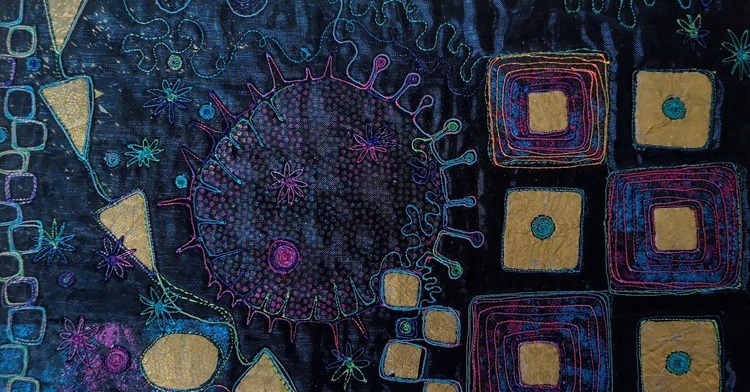
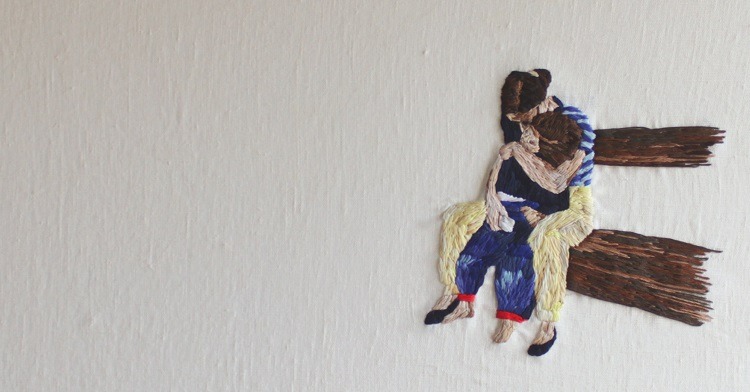
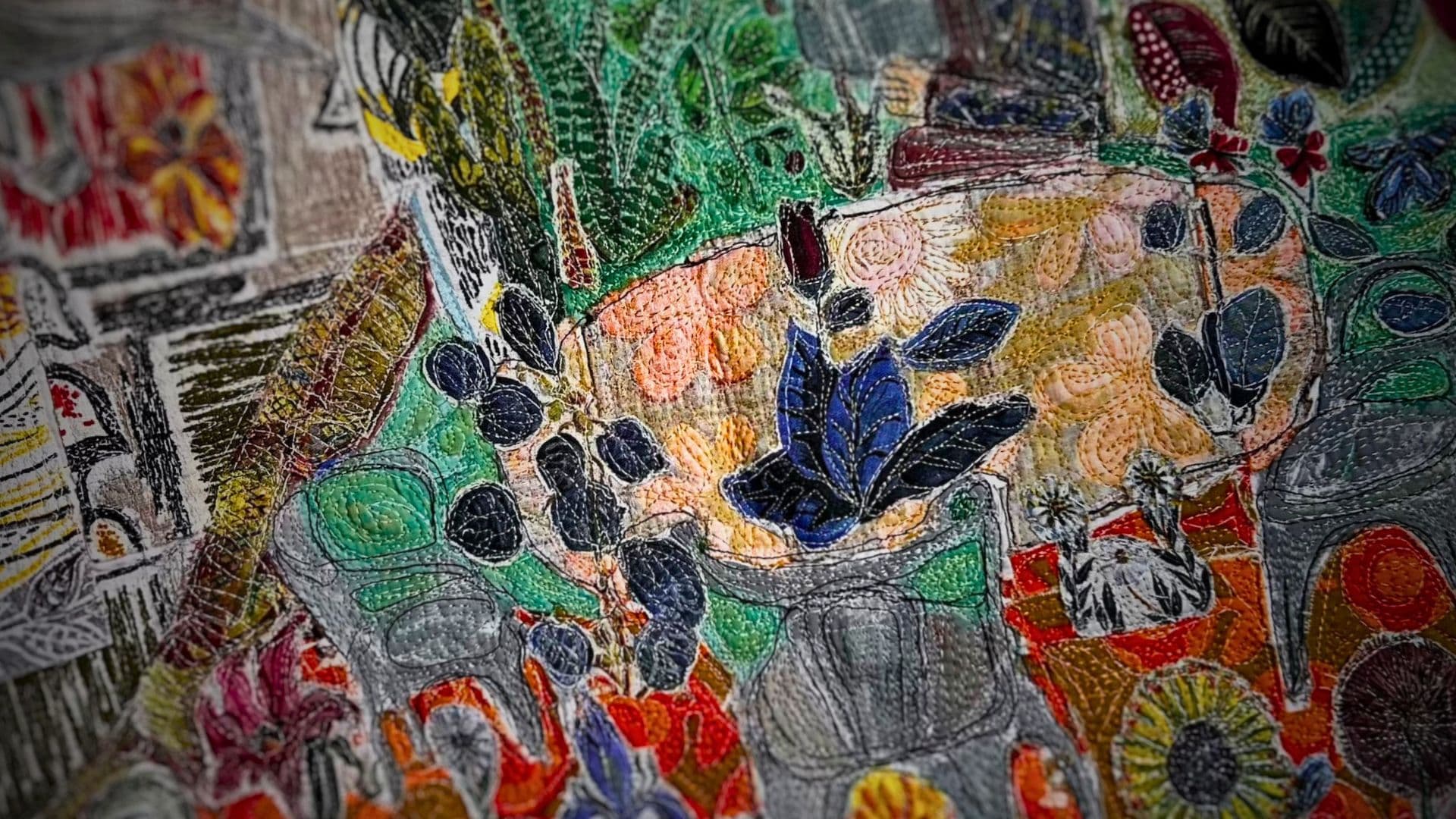
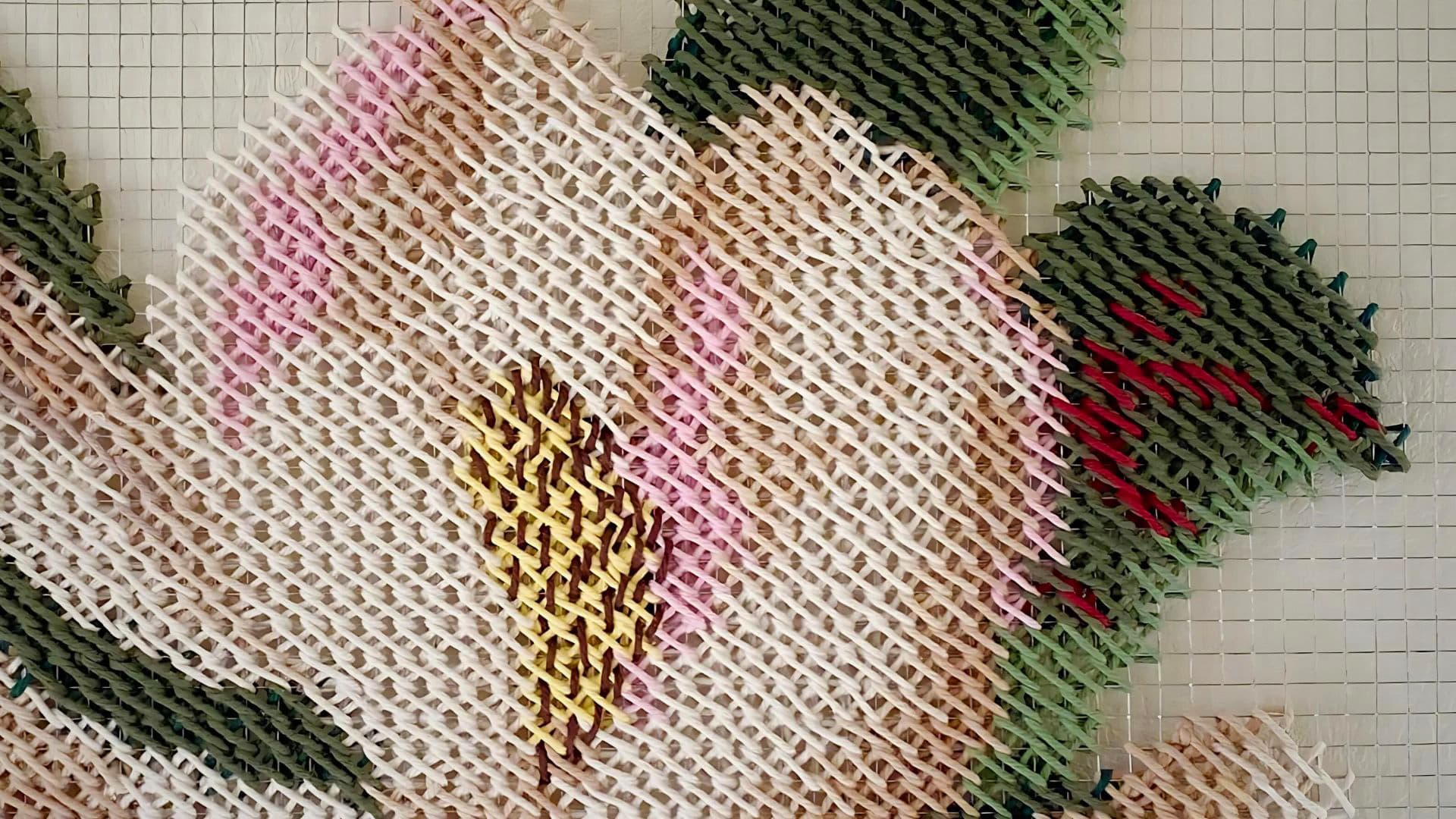
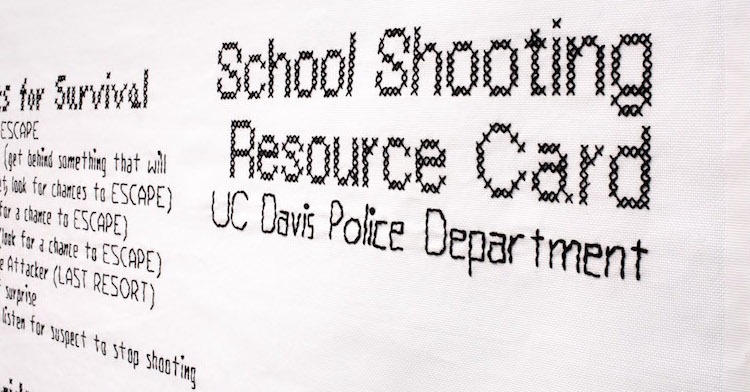
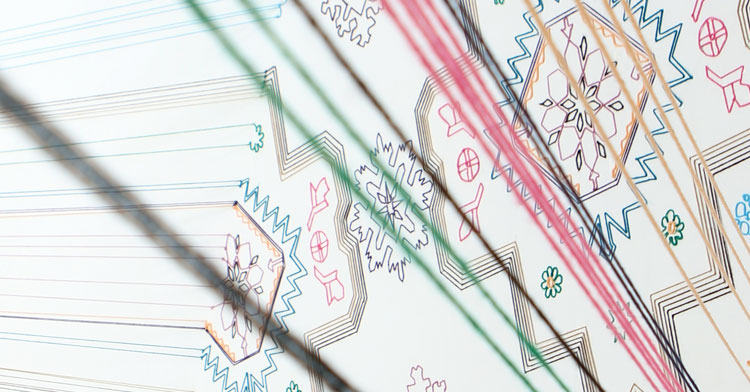
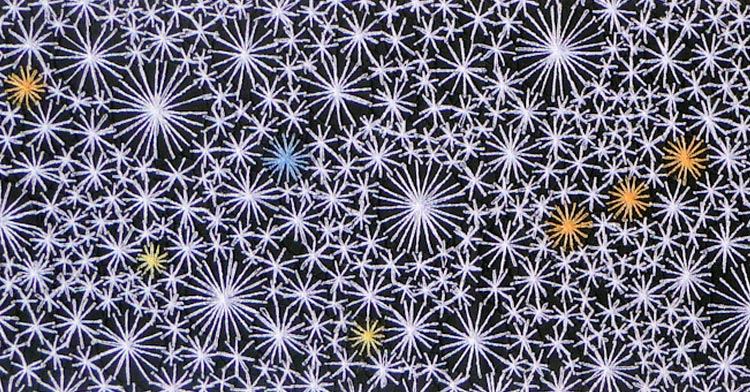
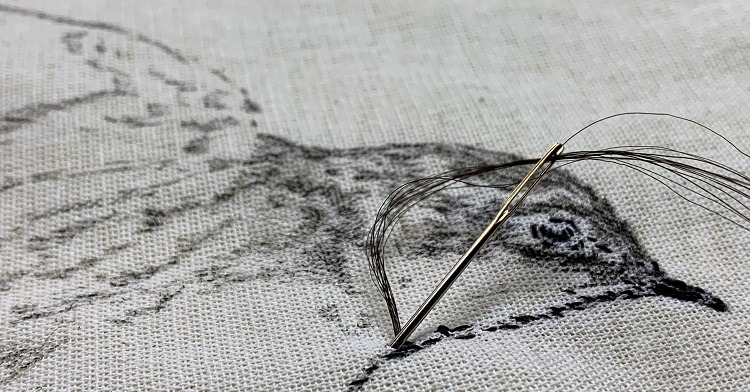
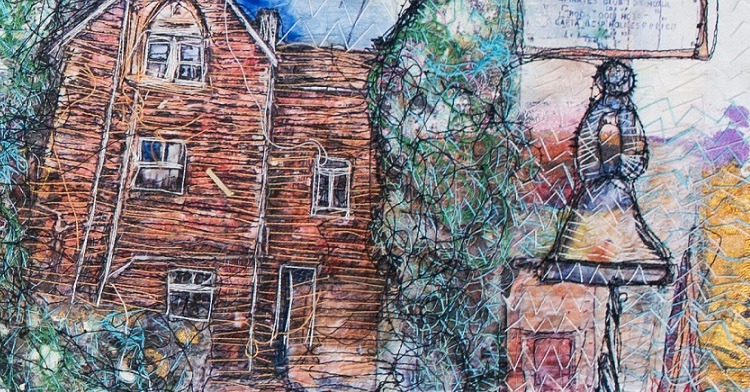


3 comments
Deb Baker
What absolutely GORGEOUS work! I don’t know if it’s possible, but I’d love to do a Zoom workshop with Angie sometime–maybe this fall? (I live in the US, EST). I signed up via email to get in touch.
Sheila Appleton
Angie’s a brilliant tutor. She runs 1 and 5 day courses on Zoom as well as at venues.
Check out her website for details.
I’m really looking forward to her 5 day Zoom Easter School course next week!
Margaret Pratt
What a blast from the past.
In 1990 l had just returned from 3 years on Germany where I studied C & G, specialising in Peruvian Textiles. My special study was exhibited in the Art of the Stitch.
I have worked with Angie before and look forward to being inspired to ‘play’ once more.